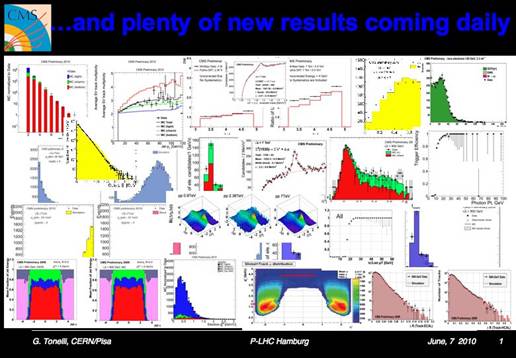Symmetry Magazine: Scientists present first “bread-and-butter” results from LHC collisions
It’s been just over two months since the first high-energy proton collisions took place in the Large Hadron Collider, and
 |
| One slide from CMS spokesperson Guido Tonelli's presentation, showing a preview of the results to be presented by members of the CMS collaboration at "Physics at LHC." |
LHC scientists have not yet found the Higgs boson, nor any hints of supersymmetric particles; these discoveries require much more collision data than has yet been collected. But nevertheless there is excitement among the 270 conference participants, who have been waiting years–in some cases decades–for the first proton-proton collisions at the LHC. With these data, particle physicists are doing what they call “bread-and-butter” physics: rediscovering the Standard Model.
The Standard Model of particle physics is the best theory that physicists currently have to describe the building blocks of the universe. With the exception of the discovery of the Higgs boson, the model has been very precisely measured at other particle accelerators and can thus be used as a touchstone to see if the LHC detectors work properly. Physicists also repeat Standard Model measurements to verify that their simulated data correspond to real data. The simulated data, also known as Monte Carlo data, will play a critical role in future discoveries.
The spokespeople of all four major LHC experiments–ALICE, ATLAS, CMS and LHCb–kicked off the first day of the conference by presenting results from their experiments since the first low-energy collisions in November 2009. All four spokespeople reported that the detectors work exceptionally well, have been able to record most of the collisions provided by the LHC, and that the known Standard Model is emerging beautifully in all of them. The CMS collaboration, for example, has caught the J/ψ particle 1,230 times.
“In other experiments I suffered a lot and for a long time to reach this point,” recounted CMS spokesperson Guido Tonelli. “At the LHC we get there in a few weeks. Amazing.” Tonelli was similarly proud of the detector’s performance in a process that hunts for secondary decays of beauty quarks, called b tagging. “There were people who thought it would be years before sophisticated techniques like b tagging could be used.”
With their detector recording an uptime of 90 percent, and good agreement between Monte Carlo data and real collisions, the members of the ATLAS collaboration are also having fun rediscovering the Standard Model. ATLAS spokesperson Fabiola Gianotti pointed out that the production of W and Z bosons had been previously measured, “but never before in proton-proton collisions.” ATLAS has submitted a total of six million jobs to the Worldwide LHC Computing Grid, with a total of 45 billion events analyzed.
Just as happy with their new collision data is the LHCb collaboration. Because of its salami-like slices (rather than the onion-like layers of the other three major LHC experiments) LHCb could not use cosmic rays to check and align its subdetectors. Precise detector alignment is crucial for experiments that are measuring the decays and paths of fundamental particles, thus the first collisions were especially important for LHCb, said spokesperson Andrey Golutvin. Similarly, spokesperson Jurgen Schukraft reported that ALICE detector is now now aligned and “literally in good shape.”
Bread and butter have never tasted so sweet.
Source: Symmetry Magazine